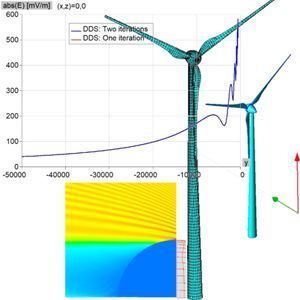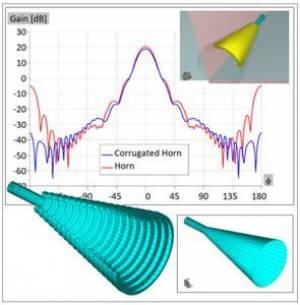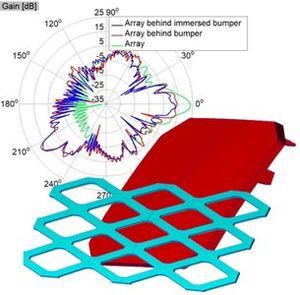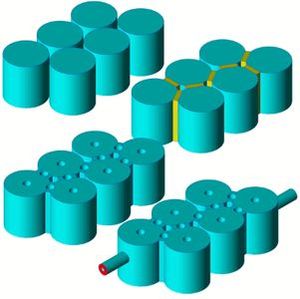Дополнительные материалы по программному обеспечению WIPL-D
Domain Decomposition Solver in Simulation of the Electrically Large Reflector Antenna
An electrically large Cassegrain reflector antenna was modeled using WIPL-D Pro and simulated using WIPL-D Pro and Domain Decomposition Solver (DDS) and calculated radiation patterns were compared. The simulations were carried out using WIPL-D Pro, a full wave 3D electromagnetic Method-of-Moments based software which applies Surface Integral Equations on one side and iterative Domain Decomposition Solver on the other side.
In regard to a large electrical size of the structure, one can say that the results were calculated in relatively short amount of time. In addition, the workstation on which the calculations were performed is by no means a cutting edge or highly sophisticated machine but an affordable desktop PC empowered with GPU cards.
Wideband Monopole Antenna Simulated with Rotational Symmetry Option
Two models of the wideband monopole antenna have been simulated using WIPL-D Pro Software. In particular, S-parameters and radiation pattern at 0.6 GHz of the monopole antenna were calculated and compared. Besides, some details regarding the monopole modelling and the particularities related to Rotational Symmetry setting are presented.
The first calculation being carried out without any simplifications applied, and the second calculation is performed with rotational symmetry applied through Rotational Symmetry option when the n-th part of the antenna structure is modeled. The comparison has confirmed that the simulations carried out using Rotational Symmetry option provide highly accurate results in much shorter time.
Printed Monopole Antenna for 5G Network Frequency Bands
The analysis of an antenna which can operate in 5G network frequency bands using WIPL-D Software has presented in this application note. In particular, S-parameters and radiation pattern of a printed monopole antenna fed with coplanar waveguide have been calculated are compared.
All the simulations and the modelling were carried out using WIPL-D full wave 3D electromagnetic Method-of-Moments based software which applies Surface Integral Equations. The simulations are very fast and accurate and in a good agreement with the results presented in referenced paper.
Windmills WIPL-D EM Simulations
The WIPL-D implementation of MoM is an ideal candidate for RCS simulations of electrically large structures. A number of features leads to this: unique quad mesh applying higher order basis functions, CAD tool providing the optimum mesh, efficient implementation at CPU/GPU platforms and number of methods to reduce number of unknowns at EM insignificant model parts.
The code is pushed to the limits for the case of wind turbines. The main challenge represents the electrical height of the mils which is very large at frequencies of interest, and presence of resistive dielectric layers. The usual result required for the case of wind turbines is near field in the shadow zone.
Corrugated Horn in WIPL-D Pro Software
In this application note we compared simulated radiation pattern results for circular horn antenna and corresponding corrugated horn antenna. Also, we shortly outlined basic modelling of corrugated horn antenna with radial corrugations using WIPL-D Pro built-in object Body of Connected Generatrices.
All the simulations with the modelling were carried out using WIPL-D Software, a full wave 3D electromagnetic Method-of-Moments based software which applies Surface Integral Equations.
Large Patch Array behind Car Bumper
The application note demonstrates excellent performance of WIPL-D suite for simulation of very large arrays of microstrip patch antennas. The microstrip with finite ground plane array has over 150 elements. Simulation frequency of interest is 70-80 GHz (specifically 77 GHz).
The model of the array is placed behind large metallic grill, which is then immersed into dielectric (plastic). This mimics the realistic situation where antenna array is covered by a car bumper.
A rather simplified formula estimates number of elements in patch array as number of elements multiplied by 500. This estimation applies when patch is placed above infinite PEC plane, and increases to 1000 when the ground is finite. Here, the number of unknowns is approximately 124,000, without any number of unknowns reduction applied. With the grill added, and again without reductions, the number raises to 190,000.
Finally, reduction of referent frequency, which should be set to only 32 GHz, is used for the plastic to which the grill is immersed. This yields in 290,000 unknowns.
WIPL-D Pro CAD Modelling Tutorial – Cavity Resonator Filters
The aim of this application note is to focus to modeling cavity filters in WIPL-D Pro CAD in a form of step by step document. The six cavities filters are based on relatively simple cylindrical cavities, each of the having tuning screws. Separate tuning screws are used for tuning the coupling between cavities.
The document first explains basic concepts, modelling via built-in primitives such as cylinder or cuboid. The building blocks are transformed and positioned via rotate/translate/multiple copy. More complex objects are made via sweep. The building blocks are assembled by using various Boolean operations, such as unite, subtract, imprint, unite simplify. The entire model is made fully parametrized so that it can be tuned/optimized. The document also explains the basic principles of WIPL-D pro CAD and offers tips for modifying projects via external applications, such as Notep/MatLab. The final step is adding the WIPL-D Pro CAD built-in ports to make a simulation ready project.






